MARKET OVERVIEW
The Global Intramedullary Nail market is of paramount importance to the orthopedic industry, as it consists of developing and launching medical devices for internal fixation of fractures. It hosts a very wide range of intramedullary nails that are inserted into the medullary cavity of long bones, thereby allowing internal support and stabilization. As technology in medicine advances, the industry will be forced to change and keep pace with innovation that answers the rising demands in search of efficient and effective orthopedic treatments.
Historically, intramedullary nails have decreased recovery time by a quantum in the use of fracture management and enhanced patient outcomes. Hence, technology and growing awareness about minimally invasive surgery techniques are going to widely alter this market for such devices. The manufacturing companies are working toward optimizing nail design and the raw material composition to meet the stringent demands made by surgeons and patients.
Thus, the prospect of personalized medicine will necessarily help lift the Global Intramedullary Nail market. With 3D printing and advances in imaging techniques, intra-medullary nails custom-made to suit patients' anatomies will become quite common. This will result in better surgical outcomes, reduced risks from complications, and faster recovery times no doubt further adoption and expansion of the market are in the offing.
Geographically, the market growth will be spread across a number of regions; of these, North America, Europe, and Asia-Pacific will be major contributors. The advanced infrastructure in healthcare and high expenditure on healthcare in North America would continue to provide a fillip to the adoption of new and innovative orthopedic solutions. With strong orientation toward research and development, Europe is foreseen to remain a leader in the market, continuously pushing new innovations relentlessly and ascertaining that standards of quality and safety of the products are upheld.
The growing healthcare sector, increasing population, and rising road traffic accidents and sports injuries will make the Asia-Pacific region an important market in the near future. In countries like China and India, demand for intramedullary nails will come when awareness about advanced orthopedic treatments increases with improving healthcare facilities. These regional dynamics will help fuel growth and diversification of the Global Intramedullary Nail market.
Another important factor that will chart the growth pattern of the market is that of regulatory frameworks and compliance standards. As regulatory requirements for medical devices continue to get stringent in different regions, manufacturers will have to increasingly concentrate their efforts on building tough quality control measures into their production processes to ensure compliance with prescribed standards. This will not only ensure greater safety and efficiency as far as intramedullary nails are concerned, but it will also enhance consumer confidence in these medical devices.
Further, it is the integration of digital technologies in orthopedic practices that is going to transform the Global Intramedullary Nail market. Data analytics, artificial intelligence, and machine learning can substantially improve pre-operative surgical planning accuracy, real-time intra-operative monitoring, and post-operative care. Next-generation intramedullary nails are being developed with smart features for better patient outcomes and operational efficiencies.
The future of the market will also be sculpted by sustainability and environmental considerations. As healthcare becomes more sustainable, intramedullary nails will become more biodegradable and eco-friendly in their development. This will add to the environmental impact of medical waste and further support the broad goals of healthcare in terms of sustainability.
The Global Intramedullary Nail market leads at the front of orthopedic innovation and is bound to alter with improvements in technology, targeted medicine, and regional dynamics. The following activities for product design, regulatory compliance, and environment sustainability will make the market further proceed and grow in pace of life in treatment for fractures through effective, minimally invasive treatments across geographies.
Global Intramedullary Nail market is estimated to reach $828.5 Million by 2031; growing at a CAGR of 3.4% from 2024 to 2031.
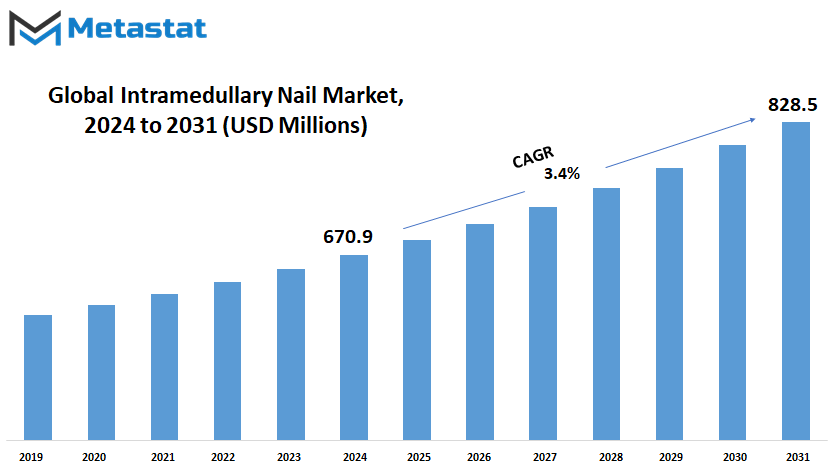
GROWTH FACTORS
Globally, the intramedullary nail market is poised to increase by leaps and bounds in the impending future, driven basically by a variety of reasons. In most orthopedic emergencies and fractures, one of the leading drivers is increasing incidence on a global scale. As the population increases and ages, the demand for effective orthopedic solutions like intramedullary nails will increase. These devices are particularly designed for internal stabilization and support of fractured bones and, under any conventional method, have distinct advantages in gaining traction amongst all demographics.
Other factors that contribute to market growth include advances in medical technologies and materials. Progress in medical technologies and biomaterials, in terms of implant designs and their processes of making biocompatible materials, enhances the efficacy and versatility of intramedullary nails in such a way that their applications improve to suit a wider orthopedic application set. These technological advancements enhance patient outcomes but also work toward increasing the overall market by expanding the scope of surgical interventions.
While there are several growth factors, the challenges threaten the market from attaining its actual potential. An example of such a noticeable obstacle is the high cost associated with surgical procedures and implants. Access to better and advanced orthopedic care is often barred due to the cost factor, especially when it comes to some of the developing regions of the world with tight healthcare budgets.
Another issue is the possibility of complications and infections brought by intramedullary nail procedures. One way to combat this issue is by looking into stricter infection controls, among other technological advancements, to combat these challenges to wide acceptance.
Being able to reduce the length of recovery periods and improve patient comfort, these systems fall into place with future trends—another large opportunity being in the area of minimally invasive intramedullary nail systems. Through taking advantage of such opportunities, manufacturers and healthcare providers could grow the market.
Although cost and risk of infection go against the Global Intramedullary Nail market, the rate of growth remains very positive, with constant technological and material development together with new surgical techniques as key future drivers of this market. Steady growth and innovations in the years ahead will be fueled by the healthcare system's focus across the world on better and more accessible orthopedic care.
MARKET SEGMENTATION
By Type
In the next few years, the Global Intramedullary Nail market will grow considerably with diversification. This market, majorly segmented into Long Gamma Nail, Trochanteric Femoral Nail, Intertroch/ Subtroch Nail, and some other developing types, is growing owing to the development of orthopedic surgeries and rising cases of fracture and bone-related disorders across the globe.
LGN, long gamma nails, continues to dominate the market, driven by its flexibility in application to many aspects of treating fractures of the femur. It offers advantages of reduced surgical trauma and faster recovery time that prove attractive to both patients and health providers. As surgical techniques continue to get refined, the use of LGNs is likely to increase and hence fuel further growth in market revenues.
Trochanteric femoral nails are specific to proximal femoral fractures, which frequently occur in elderly populations. With an aging population worldwide, TFN demand would be seen due to the ability of these nails to provide stable fixation and allow early mobilization post-operatively. With focused efforts by healthcare systems toward better geriatric care, TFN is going to become very important in improving patient outcomes.
ITST intertrochanteric/subtrochanteric nails are designed for the treatment of hip-joint-related fractures. They provide accurate fixation and stability. The constant refinement of these nails for various anatomies of patients and patterns of fractures will make them applicable in a wide sense in several health setups.
Invention of new designs and materials will be emerging types within the market, helping to further make the same dynamic. With the minimization of complications and increase in patient comfort during the recovery phase, better surgical outcomes will be aimed at. The development of innovations within advanced materials like titanium alloys and biocompatible polymers will continue to help these segments stay competitive in the market, making the same adaptable to changing medical requirements.
The Global Intramedullary Nail market is going to witness an overhaul with changing technology and demographics. With changing surgical techniques and material developments, many new opportunities will be opened up for the healthcare providers and orthopedic surgeons. Since the demand for minimally invasive procedures and individualized health care is on the rise, this market will grow rapidly by helping in the recovery of patients from traumatic injuries and degenerative bone diseases across the world.
By Material
More focus is in materials that can be named Titanium and Stainless Steel in the general Global Intramedullary Nail market. The focus would shape the important aspects in the dynamics of the market over the coming year. The use of Titanium is further utilized by manufacturers as an implant that reduces weight, increases strength, and enhances patient comfort when using the implant. It is highly biocompatible and corrosion-resistant for increased safety in long-term medical applications where the risk of allergic reactions or implant/reinforcement failure is minimized. This means that use will be driven through most orthopedic procedures, leading to dramatic increases in market growth.
In that regard, stainless steel is regarded as a strong and cost-effective range. It is, however, the strong-resisting and wear-resistant ability that guarantees its thorough carrying of loads for a long time and hence allows treatment for a more diversified range of patients with more medical needs. Therefore, its manufacturers will continue to innovate and improve upon the material's biocompatibility and reduce its weight further to be able to be more useful and applicable in worldwide orthopedic surgery.
Technological advances will only further revolutionize the Global Intramedullary Nail market. The use of advanced manufacturing techniques, for example, additive manufacturing (3D printing), may open the way to the development of new, individualized implants adapted to the anatomy of the patient. This will further the personal approach to the steps of a surgery, the outcomes, reduction in the time of convalescence, and decrease in complication rates; the overall result will be the boosting of the growth of the global intramedullary nails market.
Furthermore, smart technologies will connect those implants into sophisticated, intelligent medical devices with real-time monitoring and feedback mechanisms. This connectivity will enable health providers to track patient recovery and implant performance from a distance and to intervene on time in case of complications. Not only can such advancements deliver better patient care, but they also streamline processes in healthcare delivery, helping both the market and general adoption.
The Global Intramedullary Nail Market segmented by materials such as Titanium and Stainless Steel are on the brink of enormous growth because of recent technological innovation and material improvement that would influence implant performance, patient outcomes, and healthcare efficiency and hence intramedullary nails will prove to be the mainstay in orthopedic surgery. As this market evolves, stakeholders across the entire healthcare ecosystem would, of necessity, embrace such innovations in an effort to cash in on the emerging opportunities and address evolving patient needs with great effect.
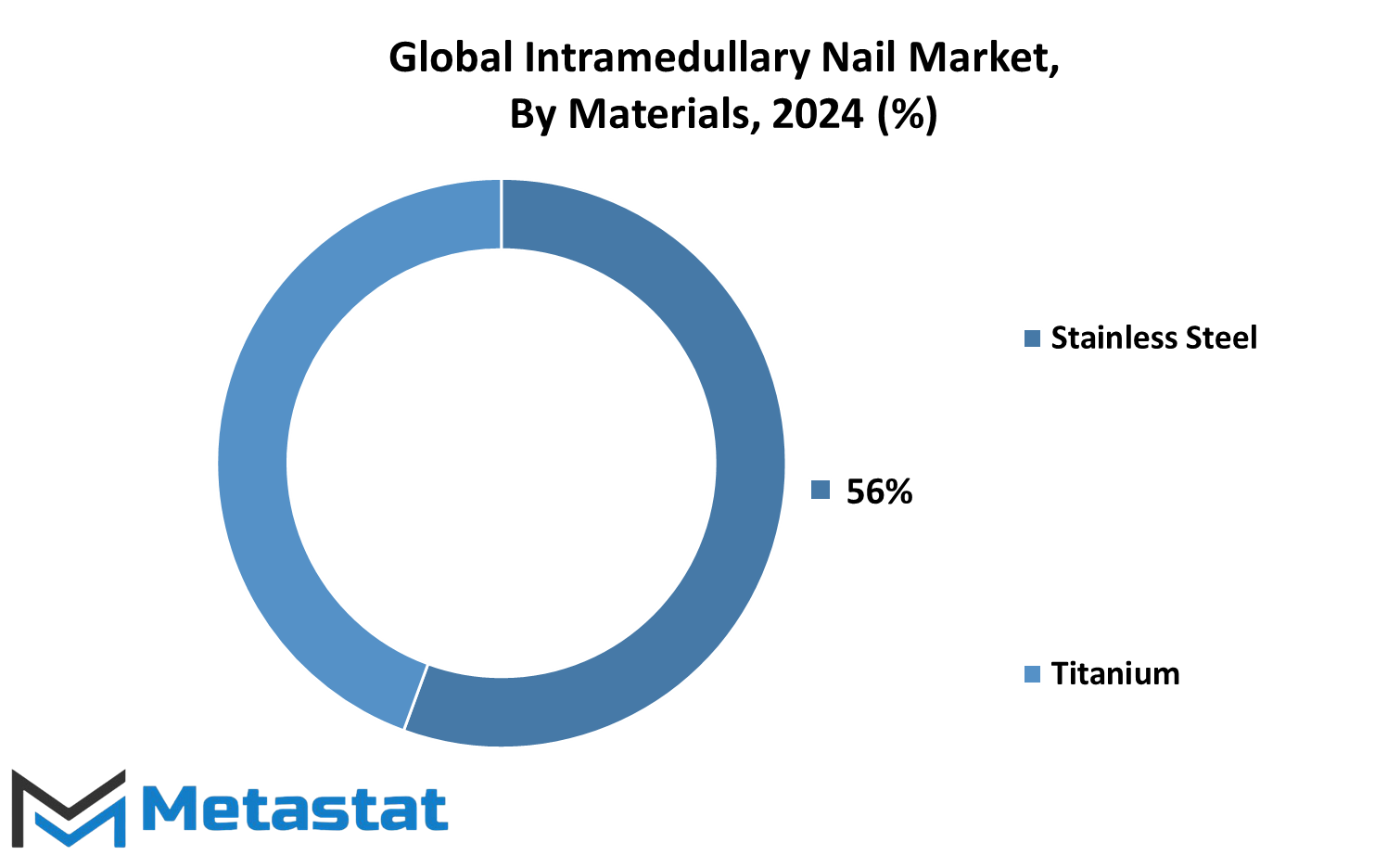
By Application
The Intramedullary Nail market globally is likely to witness exponential growth in the future, with better medical technology and the increasing occurrence of bone fractures worldwide. Intramedullary nails have been designed to stabilize fractures for faster healing and play an important role in orthopedic surgeries, especially in the case of femoral and tibial fractures, among others.
In the coming years, intramedullary nails will be much in demand due to the growing incidences of road accidents, sports injuries, and osteoporosis-related fractures among older people. These factors will help drive the market as healthcare facilities in different parts of the world increasingly adopt advanced surgical techniques and implant materials.
Femoral fractures hold a fairly high market share due to the fact that hip fractures are very common in elderly patients and there is a dire need for effective surgical interventions to return mobility and quality of life. Intramedullary nails designed for femoral fractures have advantages such as minimal tissue damage, quicker recovery time, and reduced post-operative complications, thus increasing their adoption rate.
Similarly, intramedullary nails for tibial fractures form a niche area in the domain of orthopedic trauma management. Most tibial fractures are sustained due to high impact injuries or accidents and hence require stable fixation for the proper healing of the bone and to prevent long-term mobility issues. Evolving novel nail designs with their locking and nonlocking mechanisms will also enhance surgical outcomes and patient recovery.
Other areas of application by the intramedullary nails market, besides the femoral and tibial fractures, include the humeral fractures and upper extremities. Such segments are most likely to grow at stable rates in the near future as research and development efforts are still on to enhance implant materials and surgical techniques, thereby improving the overall patient outcome.
Advancements such as 3D-printed implants and bioresorbable materials will bring a sea change in the intramedullary nail market, providing personalized solutions for the reduction of risks arising from implant-related complications. In addition, the incorporation of digital health technologies for pre-operative planning and post-operative monitoring will go a long way in smoothening surgical procedures and the optimization of patient care.
In a nutshell, it is expected that with increasing volumes of surgeries and technological advancements, the Global Intramedullary Nail market will prosper. It is through innovations in implant design and surgical technique that the achievement of the best possible outcome for patients will be able to define the future of orthopedic trauma care around the globe.
By End User
The Global Intramedullary Nail market is likely to grow substantially with its increasing adoption across the end-user segments. Principally used in hospitals and ambulatory surgical centers, specialty/orthopedic clinics, these devices form one of the integral parts of orthopedic surgeries. They are designed for stabilizing the fractures of long bones, specifically femur and tibia, and provide several advantages to patients by reducing their recovery time and improving their mobility.
The next couple of years will be aimed at developing more strength and functionality through further development in material sciences and manufacturing technologies so that intramedullary nails can bear more stress without fracturing. In this connection, titanium and stainless steel alloys will remain much in demand since they offer strength and facilitate adherence to the prescribed medical standards. More importantly, integrating some of the smart technologies, such as monitoring sensors that help in data collection for post-operative analysis, will revolutionize this patient care field by providing real-time feedback to healthcare providers.
From a market perspective, the demand for intramedullary nails will increase with rising aging populations worldwide, resulting in related cases of fracture incidences and orthopedic surgeries. In developing economies, the infrastructure in healthcare facilities would undergo rapid development, further catalyzing the market growth. The introduction of minimally invasive surgical techniques is evolving at a rapid pace and will raise the popularity of these nails by reducing surgical risks and enhancing patient outcomes.
While the competitive landscape evolves through product differentiation on which key players are focused with advanced features such as enhancing biocompatibility and infection-resistant coatings, strategic partnerships and mergers will continue to consolidate the market in an environment that can drive innovation and further expand the market.
Regulatory frameworks will play a very significant role in the growth of the market by enforcing safety and efficacy of products across markets. Continuous investments in research and development will be of importance in sparking innovative technologies that would expand the use of intramedullary nails in orthopedic treatments.
Technological advancements, increasing healthcare investments, and demographics favoring orthopedic interventions are set to give a fillip to the Global Intramedullary Nail market. These implants will, therefore, evolve with progressing medical science, bringing enhanced functionalities and contributing significantly toward the wellness of patients worldwide.
|
Report Coverage |
Details |
|
Forecast Period |
2024-2031 |
|
Market Size in 2024 |
$670.9 million |
|
Market Size by 2031 |
$828.5 Million |
|
Growth Rate from 2024 to 2031 |
3.4% |
|
Base Year |
2022 |
|
Regions Covered |
North America, Europe, Asia-Pacific Green, South America, Middle East & Africa |
REGIONAL ANALYSIS
Now, moving on to the regional dynamics of the Global Intramedullary Nail market, one has to consider its segmentation across major continents and regions in the world. Being a critical component in orthopedic surgery and an instrument specifically used to stabilize bone fractures and correct bone deformity, it exhibits varied trends across different geographic regions.
North America is the largest, comprising the United States, Canada, and Mexico, due to advanced healthcare infrastructure, high expenditure on health care, and a huge burden of orthopedic diseases. Besides, the high adoption rate of advanced medical technology and increasing investments in health care facilities further enhance market growth for this region.
Now, turning toward Europe—itself encompassing the UK, Germany, France, Italy, and the rest of the European countries—the increasing elderly population, which is more prone to orthopedic diseases, will be the growth driver. Betterment in surgical procedures due to technological progress, along with an increase in healthcare awareness among the population, will serve as drivers for the market.
The huge growth potential market in countries in the Asia-Pacific region, such as India, China, Japan, South Korea, and others, will be fueled by large patient populations, rising disposable incomes, improving healthcare infrastructure, and augmented demand due to tourism for quality medical services. The economic growth and initiatives to enhance access to healthcare are major drivers for intramedullary nails.
The same trend is foreseen in South America, along with Brazil and Argentina, in orthopedic surgeries and implants, driven by the aging population and increasing cases of sports-related injuries. Improvements in healthcare facilities and increasing expenditure on healthcare are likely to support the growth of this market.
The Middle East & Africa are further segmented into GCC Countries, Egypt, South Africa, and Rest of Africa. An increasing orthopedic procedure count can be seen in these regions since their healthcare infrastructure is slowly improvising and people are gaining awareness about the latest treatment options. Government plans to improve healthcare services and facilities are also fuelling the growth of the market.
Regional dynamics in the intramedullary nails market are really diversified, having demographic trends, development in healthcare infrastructure, technological advancements, and expenditure on health care. As the regions evolve, the demand for new and improved orthopedic solutions, like intramedullary nails, will surge and continue to move the market forward in the near future.
Essentially, these regional nuances must be understood by stakeholders looking to tap emerging opportunities and navigating the Global Intramedullary Nail market effectively.
COMPETITIVE PLAYERS
Only a few players are contributing significantly to the competitive landscape of the intramedullary nail market. These firms are leading the way with regard to innovation, better surgical outcomes, and increasing market reach. Companies like Zimmer Biomet, Stryker Trauma, Smith & Nephew, and Orthofix, leaders in advanced orthopedic solutions, are at the forefront. Such giants back extensive research and development efforts to bring cutting-edge technologies that will redefine the face of orthopedic care in the years to come.
Aap Implantate and Treu Instrumente then come in with precision engineering and reliability in intramedullary nails. CarboFix Orthopedics and Wego Ortho provide specialized or niche capabilities by focusing on low-weight yet biomechanically efficient materials in their products. More economical solutions come from Kanghui Orthopedic and Jinlu Group Medical Instruments to further penetrate deeper into global markets.
Through technological innovations and strategic expansion, Xinrong Best Medical and B. Braun Melsungen AG could gain more advantages as the market evolves further. GPC Medical Ltd. and Johnson & Johnson Services, Inc. innovate patient-centered designs and sustainable orthopedic solutions. Orthopedic Implant Company and Acumed move ahead in terms of surgical techniques and post-operative care to facilitate the fastest possible recovery and maximum satisfaction of patients.
Bioventus and Globus Medical are both concentrated on biologics and minimally invasive techniques. This is very close to the trend of the industry: less-invasive procedures with faster rehabilitation times. The AO Foundation and Integra LifeSciences have a strong belief in collaborative research and education in the field.
In the near future, the intramedullary nailing market will grow further in competitiveness, as these players fight on the battlegrounds of innovation and strategic partnerships to gain market share. This chapter identifies some emerging trends in terms of personalised medicine, 3D printing, and integration of digital health into clinical practice that will lead to future growth opportunities while helping address evolving patient needs.
The competitive landscape for the Global Intramedullary Nail comes alive and dynamic, driven by myriad industry leaders dedicated to the advancement of orthopedic care across the world. These players will be of importance in shaping the future of orthopedic surgery and, subsequently, better patient outcomes in an ever-evolving setting of technological development.
Intramedullary Nail Market Key Segments:
By Type
- Long Gamma Nail (LGN)
- Trochanteric Femoral Nail (TFN)
- Intertroch/Subtroch Nail (ITST)
- Others
By Material
- Titanium
- Stainless Steel
By Application
- Femoral Fracture
- Tibial Fracture
- Others
By End User
- Hospitals & Ambulatory Surgical Centers
- Specialty/Orthopedic Clinics
Key Global Intramedullary Nail Industry Players
- Zimmer Biomet
- Stryker Trauma
- Smith & Nephew
- Orthofix
- Aap Implantate
- Treu Instrumente
- CarboFix Orthopedics
- Wego Ortho
- Kanghui Orthopedic
- Jinlu Group Medical Instruments
- Xinrong Best Medical
- B. Braun Melsungen AG
- GPC Medical Ltd.
- Johnson & Johnson Services, Inc.
- Orthopedic Implant Company
WHAT REPORT PROVIDES
- Full in-depth analysis of the parent Industry
- Important changes in market and its dynamics
- Segmentation details of the market
- Former, on-going, and projected market analysis in terms of volume and value
- Assessment of niche industry developments
- Market share analysis
- Key strategies of major players
- Emerging segments and regional growth potential



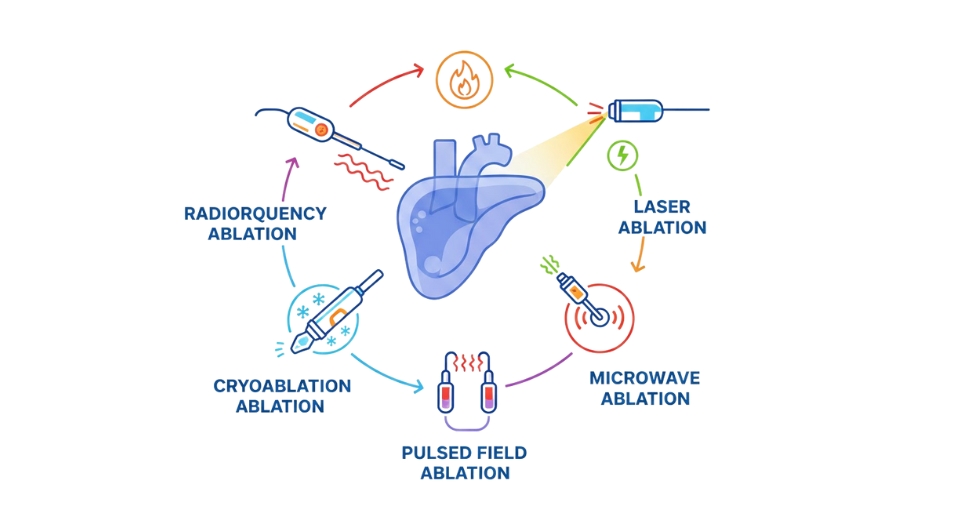

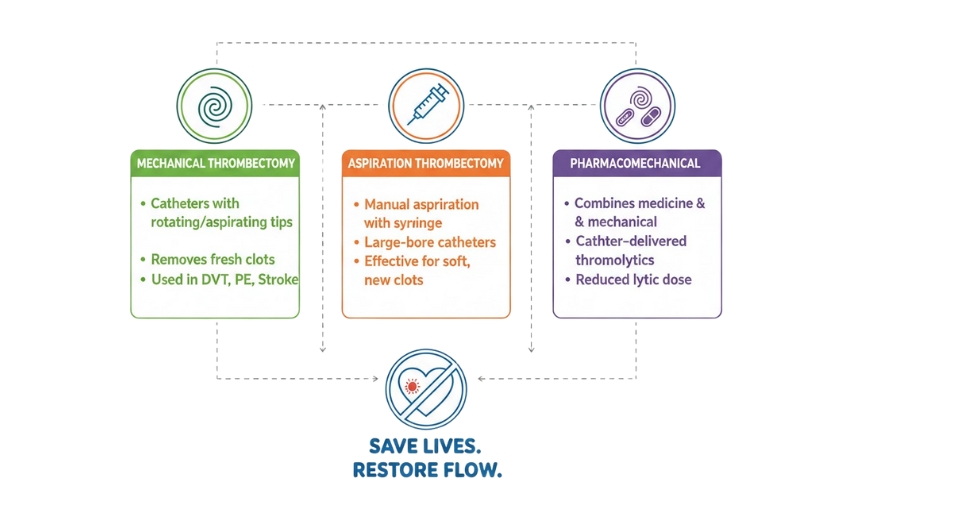
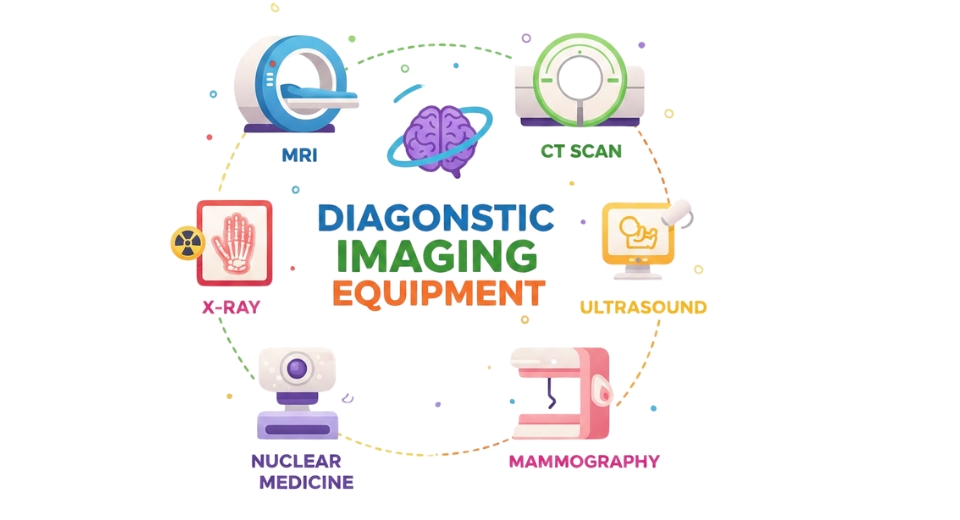

 US: +1 3023308252
US: +1 3023308252






